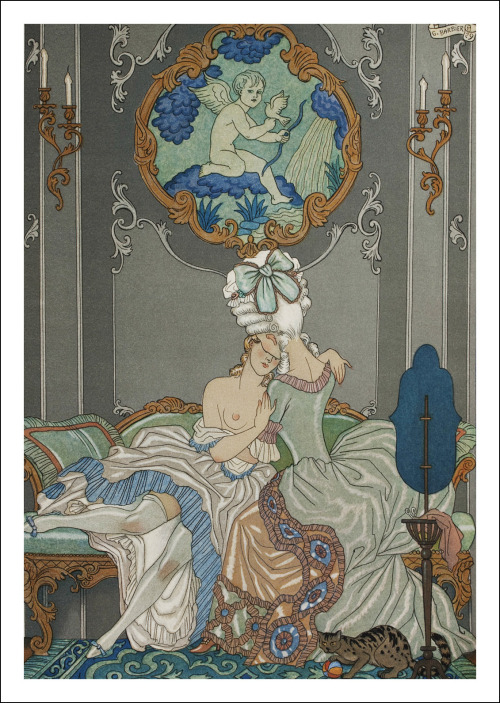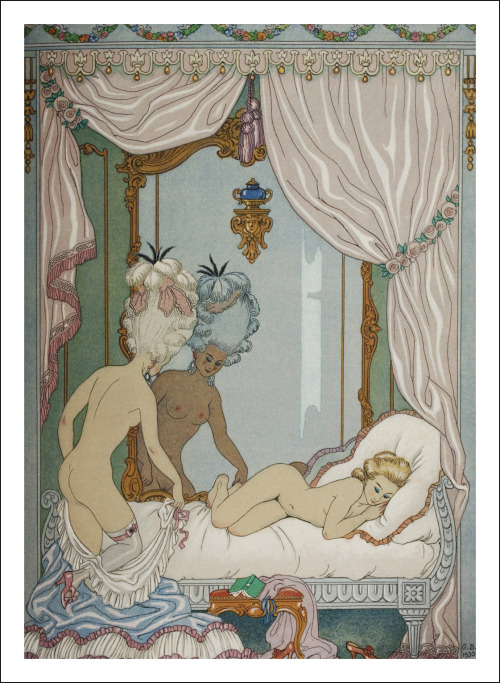thefingerfuckingfemalefury:brookietf:thefingerfuckingfemalefury:priestessamy:thefingerfuckingfemalef
thefingerfuckingfemalefury:brookietf:thefingerfuckingfemalefury:priestessamy:thefingerfuckingfemalefury:ficklerecluse:secretlesbians:George Barbier, Illustrations for Les Liaisons Dangereuses by Pierre Choderlos De Laclos, 1934.During his life, George Barbier was one of France’s most acclaimed illustrators and designers, a forefather of the art deco movement. But after his death in 1932 he quickly sank into obscurity. It’s only in the modern era that his work has been reappraised.George Barbier, Illustration for Les Chansons de Bilitis byPierre Louÿs, 1929.Barbier is notable for his bold depictions of female sexuality, and an aesthetic in his design work that a modern critic called ‘a kind of lipstick lesbian chic’. Many of his illustrations have a sapphic subtext, featuring women together in intimate poses, or women embracing people of ambiguous gender. Some show women dancing or being affectionate with figures that appear to be male but on closer inspection are clearly women in drag. George Barbier, Le Feu (The Fire), 1925. This illustration shows a woman reclining in the arms of a person of indeterminate gender.In his illustrations for Les Liaisons Dangereuses and Les Chansons de Bilitis, this subtext became outright text, with women naked together, kissing or making love. For the time, these illustrations were extremely daring and verged on the pornographic (even if they seem quite tame by today’s standards). George Barbier, Illustration for Les Chansons de Bilitis byPierre Louÿs, 1929. Little is known about Barbier’s personal life in his hometown of Nantes, but we do know that in Paris he moved almost exclusively in homosexual circles. He was an intimate friend of the dandy and poet Robert de Montesquiou, and mixed with gay intellectuals like Marcel Proust. George Barbier, Les dames seules (the single ladies), 1910. This early work is particularly striking for its apparent depiction of a butch/femme subculture among gay women in Paris.His sexuality gave him access to the underground gay scene in Paris, and his knowledge of it filters through into his work. Although many of his illustrations are fictional, fantastical, or historical, here and there we see glimpses of the hidden lives of queer women in fin-de-siecle Paris.It also makes his work particularly notable, IMO, because unlike many of his straight male contemporaries, he did not depict sex and romance between women for the titillation of the straight male gaze. His women are complex, resisting bland stereotypes or didactic stories of innocence and fallen virtue. They are beautiful, sensual, dangerous and daring. Even idealised, they seem like real people. They have a self-possession that resists objectification. Their sexuality belongs to them, not to the viewer.Links:* The Forgotten Art of French Illustrator George Barbier, New York Times, 2008 (With thanks, much of the detail of Barbier’s life is drawn from this article).* George Barbier: Fashioning the Queer Identity, MA Fashion Blog, 2016.* Further illustrations from Les Liaisons Dangereuses.* Further illustrations from Les Chansons des Bilitis.@thefingerfuckingfemalefury have you seen this?I am ALL ABOUT this beautiful vintage lesbian french artwork right here <3_<3thats gayHELLA :D Wow this is all so beautiful :OIt’s soooooooo incredibly lovely <3I wanna decorate my home with this wonderful lesbian art <3_<3 -- source link
#nsfw#ladies#art#lgbt+#art history#long post#thank#george barbier

